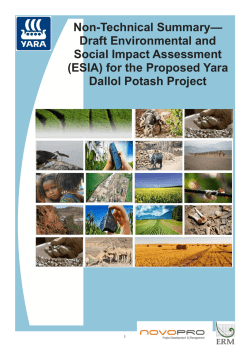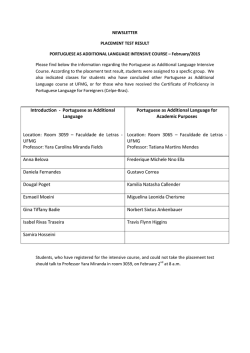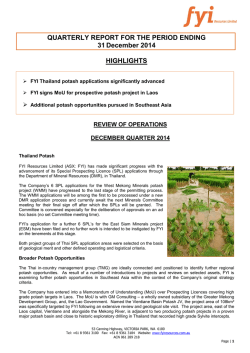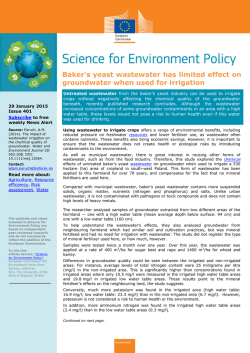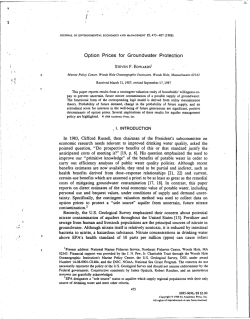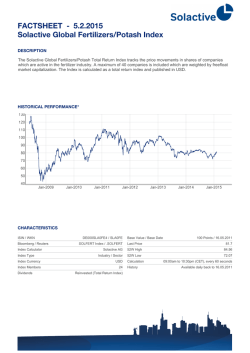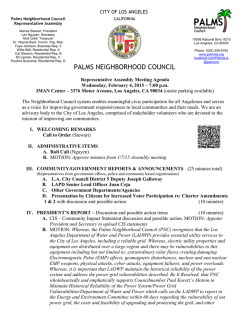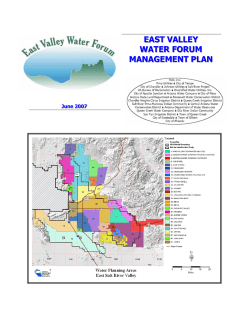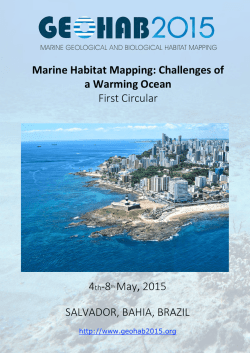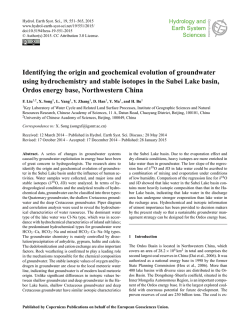
Chapter 14
14 CONCLUSION 14.1 PROJECT BACKGROUND Estimated global consumption of potash in 2013 was 56 million tons, and more than 90% of this consumption was covered by MOP (Muriate of Potash, KCl). In the same year, 8% of global potash consumption was supplied by Sulphate of Potash (SOP) (approximately 4.5 million tons). SOP has certain agronomic advantages (such as a low chlorine concentration) that are necessary in the application to certain high value cash crops (mainly fruits and vegetables), which are sensitive to high levels of chlorine. As a result, SOP is valued in the market as a premium potash product, and therefore achieves price premium over MOP. However, this said, the extent that SOP can be used as a substitute for MOP will depend on future price differences between these two products. Yara International is a leading global fertilizer company with sales of fertilizer to about 150 countries globally. Yara International, with its global marketing and distribution division, will be targeting these high value crop segments in Africa, Asia, South Europe and South America. As part of Yara International’s overall upstream strategy, the company is exploring for suitable raw material sources that can be developed and used as a source for o Yara International’s global fertilizer production and directly as finished product in its product portfolio. To complement these upstream processes, Yara International has recently started a subsidiary company, Yara Dallol BV, which is involved in the exploration and mining development of potash concessions in Ethiopia. These concessions are located in Dallol in the Danakil Depression, Afar National Regional State (ANRS), Ethiopia. The potash resource in the Danakil Depression (Ethiopia) has been known for many decades and is, from a resource perspective, considered to represent a potential high grade and shallow depth resource base for the production of SOP. Yara International, through its subsidiary, proposes to develop a potash mine – the Yara Dallol Potash Project (the proposed Project) within three concession areas (Musley (1), North Musley and Crescent). The resource potential of this area is significant, and has the potential to produce 600,000 metric tonnes of potash per annum for approximately 20 years based on the resources in the western part of North Musley alone. A comprehensive technical and financial feasibility evaluation of the proposed Project is currently being undertaken in parallel to the ESIA and will be (1) Please Note – Yara Dallol BV currently holds one exploration license for North Musley and Crescent Concessions (Reference No.: MOM/0130-0134/2000) and is (as a result of the license lapsing) in the process of re-applying for an exploration license for the Musley Concession. Moreover, once mineral resources have been verified and feasibility concerning the proposed Project verified, Yara Dallol BV will be applying for mining rights for all three concessions (North Musley, Crescent and Musley). As a result it is deemed appropriate to include the Musley Concession in the overall ESIA Study Area and to assess the likely social and environmental impacts to sensitive receptors that occur within this area so as to suggest appropriate mitigation / management measures. ENVIRONMENTAL RESOURCES MANAGEMENT YARA DALLOL BV 14-1 completed and submitted to the Ethiopian Ministry of Mines (MoM) on the same date as the Final ESIA. This said, preliminary economic evaluations carried out in the early stages of the Project have indicated that the proposed Project will be financially feasible. Feasibility will be refined as the project develops and will be concluded as part of the Definitive Feasibility Study (DFS), scheduled for completion in January 2015. 14.2 ENVIRONMENTAL AND SOCIAL IMPACT ASSESSMENT (ESIA) PROCESS Under the Ethiopian Environmental Impact Assessment (EIA) Proclamation (No. 299/2002), the proposed Project requires an EIA and authorisation by the Ministry of Environmental Protection and Authority (MoEF) before any mining activities may commence. However, although the MoEF is mandated to drive environmental impact assessment processes in Ethiopia, the Ministry of Mines (MoM) has within its department MoEF representatives. As the proposed Project is mining related, the MoEF has delegated review and decision making authority to the MoEF delegates within the MoM. Yara Dallol BV have appointed Environmental Resources Management Southern Africa (Pty) Limited (ERM) as independent environmental practitioners to undertake an Environmental and Social Impact Assessment (ESIA) (1) for the proposed Project. This ESIA is being undertaken in accordance to the Ethiopian EIA Proclamation (No. 299 of 2002) and associated EIA Guideline Document (2000) and the Draft EIA Guideline for Mineral and Petroleum Operation Projects (Series 1, 2003), all of which are published by the Federal Democratic Republic of Ethiopia’s Former Environmental Protection Authority and now Ministry of Environment and Forestry. In addition to the applicable regulations and norms of the government of Ethiopia, the proposed Project has committed to comply with the requirements of the International Finance Corporation (IFC) and the World Bank Safeguard Policies. The ESIA (this report) is the second and final phase of the overall EIA process being undertaken in support of the proposed Project. The purpose of the ESIA report is to: x Present a detailed baseline review of the physical, biophysical and social characteristics of the Project Area (2) and surrounds; (1) The use of the term ESIA as opposed to EIA is to emphasise that the process will not only assess environmental impacts but will also assess potential socio-economic impacts of the proposed Project. (2) Please Note – the Project Area is defined as Yara Dallol BV’s two concession areas (namely the North Musley and Crescent concessions) and the Musley (which is under an exploration area extension application), but also includes the surface areas outside of Yara Dallol BV’s concession areas that will be used for linear infrastructure (including pipelines and access roads located outside of the concession area that will connect to water and power supply corridors and to other main routes), as well as alluvial fans located outside of the Yara Dallol BV concession areas, that will be used as a source of water supply to the proposed Project. These areas are directly to the west of Yara Dallol BV’s concession area. The areas directly to the north of Yara Dallol BV’s concession area are included in the G&B Central Africa Resources Plc concession. This is illustrated in Chapter 2 of this report. ENVIRONMENTAL RESOURCES MANAGEMENT YARA DALLOL BV 14-2 x Assess the impacts (including cumulative impacts) of the physical, biophysical and social environments related with the different phases of the proposed Project; and x Provide mitigation measures and associated management plans that aim to avoid /minimise/manage the severity of identified impacts. 14.3 ESIA FINDINGS 14.3.1 Positive Social Impacts The proposed Yara Dallol Potash Project is expected to have the following positive social impacts: x Increased Government Revenue – the proposed Yara Dallol Potash Project’s direct contribution to Government revenue will be through the payment of income taxes , export taxes, withholding taxes (1), royalties, economic contribution (value added), and payment to suppliers and expatriate staff. x Creation of Employment Opportunities – it is anticipated that approximately 1,000 direct employment opportunities will be created by the proposed Project at the peak of construction in June 2016. The majority of the construction jobs will be temporary in nature and is intended to be a mix of locals, people from the Afar region, and people from elsewhere in Ethiopia as well as expatriates. Operational activities are expected to require a workforce of approximately 980 people (including staff, support staff and product truck drivers). The proposed Project is, further, anticipated to create in-direct and induced employment opportunities. Indirect employment opportunities are expected to occur at a regional level, elsewhere in Ethiopia and abroad. Induced employment is expected to be limited in the region due to the limited availability of goods and services. x Skills Enhancement – the proposed Project’s provision of employment opportunities will also result in improvement of skills and experience in the Project Area and surrounds; especially amongst those who are able to secure employment with the proposed Project; thereby improving the potential for staff to achieve future employment. This positive impact will be enhanced by training received through on-the-job and more formal training courses related to production and Health and Safety and Environment (HSE) standards required for the proposed Project. x Procurement of Goods and Services – it is anticipated that with time, the potential exists for local /and regional businesses to develop and grow to (1) Withholding is a scheme of tax payment administered by the ERCA withheld by the buyer on procurement of goods and services in Ethiopia. ENVIRONMENTAL RESOURCES MANAGEMENT YARA DALLOL BV 14-3 meet at least some of the basic procurement needs of the proposed Project, especially during operations. Procurement locally will assist in creating income and building a more stable and diverse economy. As the proposed Project develops, the increased demand for goods and services should create commercial opportunities for local businesses (those opportunities are likely to be focused on the production and transformation of food products and any other locally available materials). In addition, the inmigration of migrant job-seekers and other business minded people will bring people with different experiences, knowledge and demands that will supplement the existing economic and livelihood activities and offer additional activities that will serve to diversify the local economy. 14.3.2 Negative Social and Environmental Impacts The ESIA process undertaken has identified and assessed a range of potential environmental and social impacts associated with the proposed Yara Dallol Potash Project; however, provided that the social and environmental mitigation/management measures provided in this ESIA and associated social and environmental management plans are implemented, the majority of these impacts will be reduced to a minor to negligible level of significance. Such impacts are associated with – Environmental Impacts x x x x x Surface water flow interruption and quality impacts; Groundwater quality; Air quality impacts and impacts to the noise environment as a result of activities undertaken during the construction and operational phases; Direct loss of habitat through development of infrastructure and human influx; and Loss of threatened faunal species. Social Impacts x x x x x x x x x x x Increased price inflation due to demand and economic vulnerability; Community anger and resentment over unmet expectations; Impacts associated with Project induced in-migration on Project host communities; Disturbance to cultural, values, traditional leadership and intangible heritage; Increased incidence of communicable diseases Increased transmission of malaria; Increased incidence of non-communicable diseases; Impacts related to labour and working conditions; Impacts on natural resources; Impacts to cultural heritage resource related to earthworks, vibration and in-migration; and Visual and landscape impacts. ENVIRONMENTAL RESOURCES MANAGEMENT YARA DALLOL BV 14-4 However, there remains a relatively low level of certainty around the social and biological impacts associated with the potential loss of areas of Fringe Habitat and the Killifish ponds as a result of groundwater abstraction. The ESIA has identified that over abstraction of groundwater for solution mining Projects in the Danakil may have detrimental impacts to this habitat and associated Doum Palms and Killifish ponds; however, there is still a low confidence level with respect to recharge into the aquifers targeted for groundwater abstraction. In this respect the ESIA has taken a precautionary approach to these impacts and residual impacts remain high. These are discussed in more detail below. Impacts related to Fringe Habitat and associated Doum Palms and Killifish Ponds The Project Area accommodates a narrow, well-vegetated band that is referred to as the Salt Pan Fringe Habitat. Groundwater is the primary driver that determines the layout of this habitat. The Fringe Habitats is highly sensitive in that it is dominated by clumps of Doum Palm (Hyphaene thebaica). These clumps cause an accumulation of wind born sediment at their base, which gradually leads to an increased in elevation around these clumps. Many of these clumps appear to be associated with small drainage lines which suggest a dependence on surface water flows (rain water runoff); however, the restricted distribution of these palms to the fringe habitat also suggests their dependence on the availability of the high groundwater levels which their shallow roots systems are able to access. MWH (2014) have noted that the over abstraction of groundwater is unlikely; however, this possibility cannot be ruled out entirely. Should over abstraction occur, this could result in a lowering of the water resources available to the Fringe Habitat, which in turn could result in rapid infiltration of surface water and may thus cancel both sources of water availability, suggesting a high dependence on the presence of groundwater. As such, if there were to be over abstraction of groundwater from this aquifer system (the proposed Project requires approximately 1,550m3/h process water) will lower water resource availability to Doum Palms in the Fringe Habitat and in turn may result in plant mortality. Doum Palms are highly important both from a biological and social perspective. From a biological perspective, the large clumps of Doum Palms create shady micro-habitats with soft sand for easy burrowing, and provide refuge for small mammals and reptiles that can shelter under palm fronds, making these palms a cornerstone species for maintenance of biodiversity in the Fringe habitats and the landscape as a whole. From a social perspective, Doum Palms are an important source of livelihood for the local women who harvest the palm leaves to make mats, baskets, strings for beds and other household goods. Collecting and processing of Doum Palm leaves represents the only significant income generating activity that is available to women, leaving them vulnerable to any changes in its productivity or availability. Moreover, high groundwater levels in the Fringe Habitat forms pools of water along the western margin of the habitat in the Musley North Concession which sustains an abundance of Arabian Killifish Species (Aphanius dispar). These pools are shallow and subject to high levels of evaporation, and maintenance of this habitat and the killifish species is therefore dependent on ENVIRONMENTAL RESOURCES MANAGEMENT YARA DALLOL BV 14-5 the continued flows of groundwater. The Arabian Killifish is currently recognised as a single species that is widely distributed within the Middle East and North-east Africa and is not classified on the IUCN Red List of Threatened Species database; however, it is recognised as threatened in Saudi Arabia and the only recognised subspecies A.d. richardsoni, occurring in Jordan is classified as Critically Endangered (Mir & Hamidan, 2012). Many subspecies are recognised, but a thorough taxonomic review of the species is expected to yield a large number of closely related species (Seriously Fish website, 2014), many of which are expected to have a very restricted extent and classified with a highly threatened conservation status. The local population of Arabian Killifish is therefore considered to have a threatened conservation status for the purposes of this ESIA study, until such time a taxonomic and genetic review of the locally recorded species in the Dallol has been undertaken. Although considered by MWH (2014) as unlikely, over abstraction of groundwater for the proposed Project could potentially result in depletion of groundwater resources that sustain these Arabian killifish populations. Although MWH (2014) indicate that there is a high probability that there are sufficient water reserves for solution mining by Yara Dallol BV and other mining companies in the Danakil, and that recharge into the aquifers targeted for groundwater abstraction is thought to be sufficient, long term monitoring of groundwater levels and water quality in production boreholes and observation wells, as well as community wells and boreholes, is required, both to confirm recharge parameters and to better refine a groundwater model. The groundwater model will be continually refined and updated as further data becomes available. Moreover, it is crucial that the survival rates of Doum Palms and health and survival of Arabian Killifish populations in response to groundwater abstraction are monitored. Monitoring systems will be established prior to the commencement of the operational phase and maintained through the life of mine into the decommissioning and closure phase and will only cease once positive and predictable environmental trends are established. In the event that monitoring does identify significant impacts to Doum Palms (i.e. mass mortality rates) and/or Killifish populations (i.e. drying up of ponds), then Yara Dallol BV have committed to migratory and compensatory measures included in the Biodiversity Management Plan. Such compensatory measures include artificial maintenance of existing Killifish ponds and artificial cultivation of Doum Palms. 14.3.3 Cumulative Impacts The ESIA study identified that the presence of other planned and potential developments in the broader Project Area, including – x The construction of the Ethiopian Roads Authority (ERA) double lane paved road from the Agula Town through to Berahale Town and up north to the town of Bada. ENVIRONMENTAL RESOURCES MANAGEMENT YARA DALLOL BV 14-6 x The planning of an ERA road through the lowland Danakil Basin between the town of Hamad Ela and Afdera. x The Ethiopian Electric Power (EEP) is planning on supplying a 230kV electrical line (1) to a common substation proposed in the greater Project Area. x A series of planned and existing advanced exploration companies (in addition to Yara Dallol BV) are present in the Danakil (Allana Potash Corp and G&B Central Africa Resources Plc). These developments have the potential to lessen identified environmental and social impacts, especially impacts related to over abstraction of groundwater and subsequent impacts to Fringe Habitat and associated Doum Palms and Killifish ponds. In this respect, it is recommended, that a regional water committee is established, tasked with coordinating the water abstraction from the alluvial fans. This committee should include each of the stakeholders potentially affected by large-scale groundwater abstraction from the alluvial fan aquifers; this committee should include members of local and regional government (including departments associated with water resources, environmental, and mining departments), local community representatives and representatives of each of the mining companies. The continually refined groundwater model should be used by this regional committee as a tool in the management of targeted aquifer systems in the future. In addition, management of cumulative impacts involves alignment between developers with respect to resourcing and infrastructure needs, the potential sharing of infrastructure (such as roads), the sharing of information and data, the establishment of a forum between mining companies, and transparency and buy-in from developers to mitigation and management measures adopted by all role-players in the region. 14.4 SUMMARY Provided that all the social and environmental mitigation/management measures provided in this ESIA and associated social and environmental management plans are implemented, it is the opinion of ERM that there are no environmental or social fatal flaws which inhibit authorisation of the proposed Yara Dallol Potash Project. However, with a series of planned and existing advanced exploration companies present in the Danakil the proposed Yara Dallol Potash Project cannot be assessed in isolation. The combined operational phase water requirements for these companies need to be considered. (1) It must be noted that EEP is fully responsible for the design and construction of the Overhead Transmission Line ENVIRONMENTAL RESOURCES MANAGEMENT YARA DALLOL BV 14-7 Based on the data presented in this ESIA, sufficient water for use by all three mining companies is probable; however, this resource will need to be carefully and diligently managed. Adequate management of target aquifer systems cannot be achieved by individual mining company’s separately. Aquifer systems need to be managed holistically through a joint effort between local and regional government, local community representatives and representatives of each of the mining companies. Moreover, ongoing refinement of the groundwater model and use of this model as a tool in the management of targeted aquifer systems is essential. Additionally, the survival rates of Doum Palms and health and survival of Arabian Killifish populations in response to groundwater abstraction needs to be monitored through the life of mine into the decommissioning and closure phase and must only cease once positive and predictable environmental trends are established. If monitoring identifies significant impacts to these systems then timely implementation of compensatory measures included in the Biodiversity Management Plan is recommended. ENVIRONMENTAL RESOURCES MANAGEMENT YARA DALLOL BV 14-8
© Copyright 2026
